Karstensens Shipyard completes second new midwater trawler for Galway family
South-easterly gales with gusts up to 90 knots, as Storm Deirdre tracked rapidly across the North Sea, provided an immediate test for the new Girl Stephanie G 190, as the 51.9m midwater trawler left Denmark for Ireland a week before Christmas, reports David Linkie (Photos: John Cunningham)
Although more favourable conditions would have been preferred for the delivery trip from Hirtshals to Killybegs, the poor weather gave every opportunity for Girl Stephanie to prove her seakeeping capabilities from the word go.

Girl Stephanie towing for the first time, in her customary role as starboard boat when pair-trawling with Western Chieftain. (Photo: Nial Doherty)
Skipper Tomás Conneely and the crew later reported that the new boat handled exceptionally well in the heavy seas that were experienced crossing the North Sea and the top of Scotland.
Conditions were considerably better when Girl Stephanie left Killybegs on New Year’s Day to start fishing scad (horse mackerel) northwest of Co Donegal, when – as customary – skipper Tomás Conneely paired up with his counterpart Charlie Doherty on Western Chieftain SO 237.
This maintained a well-established partnership now spanning some 20 years, and three boats of the same names. The new pair-team hit the ground running by landing 650t of scad into Killybegs in the first week of the year.
The new Girl Stephanie is the fourth boat that the Conneely family from Inis Mór, the biggest of the Aran Islands off the coast of Co Galway, have owned since 1982. Funnel crests depicting Tomás Conneely’s father Pauric’s initials, above an outline of Inis Mór, symbolise the family’s lifelong association with the Aran Islands.
Designed and built by Karstensens of Skagen, the new Girl Stephanie replaces her 45m namesake, which left the Danish shipyard in 2003. Sold last year to Norwegian owners Tronderkari AS, the previous Girl Stephanie is now in the process of being modified for use as a trawler, before starting to be fished by its new owners.
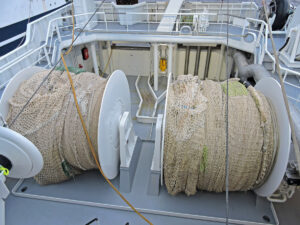
Two net drums are aligned with hydraulically operated shooting gates and rollers across the stern of Girl Stephanie…
Having been fully satisfied with the build quality and consistent level of performance that the previous Girl Stephanie gave for 15 years, when pair-trawling with the identical Western Chieftain, the Conneely family had no hesitation in returning to Karstensens. Equally, the benefits associated with two virtually identical purpose-built vessels pairing together were demonstrated by the fact that the order for the new Girl Stephanie was placed at the same time as Frank Doherty signed with Karstensens to build a new Western Chieftain SO 237 (Fishing News, 22 November).
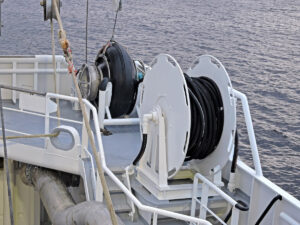
… which is rigged for pumping pelagic fish aft.
As a result, Girl Stephanie is a virtual sistership to Western Chieftain, featuring an identical hull design, working arrangements, refrigerated catch storage and deck machinery equipment. The one exception is that Girl Stephanie, like her predecessor, is equipped with a MAN 6L27/38 main engine, the choice of which highlights the owners’ complete satisfaction with this unit on their previous boat.
Developing 1,670kW @ 800rpm, the propulsion unit turns a Brunvoll 3,800mm-diameter four-bladed CP propeller system, housed in a matching nozzle, through a Brunvoll 6.4:1 reduction gearbox. Giving a maximum propeller speed of 125rpm, this centreline package enabled Girl Stephanie to return an average top speed of 14 knots on engine trials off Skagen, when sailing in ballast condition. Technological advances relating to engine efficiency, and hull and sterngear design, means that while delivering the same output as her predecessor, the new Girl Stephanie uses significantly less diesel per hour when steaming and towing.

Skipper Tomás Conneely.
A gearbox PTO is used to drive an AvK DSU 440V three-phase shaft alternator, producing 1,875kVA. Further electrical power is provided by two 560kWe Stamford generators driven by Caterpillar C18 auxiliary engines. A 129kW Caterpillar C9 harbour genset is located in the forecastle.
When shooting or hauling the midwater trawls, the gearbox PTO will be clutched in, enabling the shaft generator to supply electrical power to the deck machinery via the hydraulic packs. This operational characteristic reflects the fact that during requirement for full power on the deck machinery, there will not normally be a similar demand for power on the main engine.
During normal towing, when more engine power will be required, the shaft alternator can be disengaged, when electrical power will be supplied by either of the Caterpillar gensets, which can be connected into the main switchboard, controlled by Girl Stephanie’s fully integrated DEIF power management system. Girl Stephanie also features a frequency converter for floating frequencies between 50 and 60Hz, designed to operate with optimum levels of efficiency and economy across all modes of vessel operation. When steaming in economy mode, initial indications show that Girl Stephanie burns 120-140 litres of fuel per hour less than her predecessor.

General view in the engineroom.
Two Brunvoll tunnel thrusters – in which skew-bladed propellers give optimal thrust bow (550kW) and stern (465kW), with low noise – assist vessel handling in confined areas and keeping station to fishing gear. A combination of Rolls-Royce Tenfjord steering gear and a Rolls-Royce lift flap rudder are fitted to optimise Girl Stephanie’s manoeuvrability under all operating conditions.
In keeping with the now well-established trend on pelagic vessels to install two separate ship management systems, all remaining systems onboard Girl Stephanie – ie main alarms, engine controls, bunker tank sounding, navigation light controls, deck light control, etc – are monitored and operated through a separate system from supplier Marine Control Services.
A combination of double bottom and deep fuel tanks allow 150,000 litres of fuel to be carried. Girl Stephanie’s freshwater capacity is 13,000 litres. In the bulbous bow, 38t of seawater ballast can be carried, enabling the vessel’s handling characteristics to be fine-tuned to the prevailing conditions.
All machinery installed in Girl Stephanie’s spacious and well-laid-out engineroom is constantly monitored from the customary soundproofed control room, situated one deck higher on the port side.
Sailing with a crew of nine, skipper Tomás Conneely expects to follow a similar fishing pattern to that which proved successful with the previous Girl Stephanie, pair-trawling with Western Chieftain on a seasonal basis for a combination of mackerel and scad. After starting on scad, the catching focus is expected to switch to mackerel next month, followed by blue whiting in March. Depending on fishing opportunities, mackerel and scad will be the main quarry again towards the end of the year.
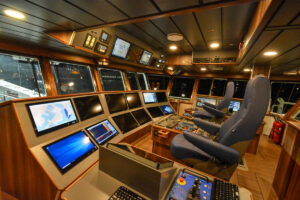
The main forward console in Girl Stephanie’s wheelhouse…
Killybegs netmaker Swan Net-Gundry maintained its longstanding relationship with Pauric and Tomás Conneely by supplying Girl Stephanie’s mackerel and scad midwater pair-trawls, which are rigged with 38-fathom braillers custom-designed for pumping pelagic fish at the stern.
As Girl Stephanie was landing in Killybegs at the end of a successful first trip, skipper Tomás Conneely said: “Everything went smoothly on the maiden trip, when the weather generally helped us to become accustomed to the boat’s characteristics, including pumping fish at the stern. Having a longstanding relationship with Karstensens, we had a fair idea of what to expect, although the end result again exceeded our expectations. The standard of workmanship throughout the boat, from the wheelhouse to the engine and RSW rooms, is superb. Karstensens have done us proud once again.

… and the fishing console.
“That Girl Stephanie fished successfully from the word go is also down to everybody associated with the design, build and supply of all main and ancillary equipment. All systems performed as anticipated, and the midwater gear was well-balanced with the vessel. Although there will inevitably be challenges ahead, not least in terms of fishing opportunities, we have every confidence that the new boat will help us to meet these in years to come.
General arrangements
Designed in-house by Karstensens Shipyard, Girl Stephanie has an overall length of 51.90m, length between PP of 50.40m, 11.20m beam, and a depth to shelterdeck of 7.25m.
Of round bilge hull form, Girl Stephanie’s hull was built to DNV-GL +1A1 Fishing Vessel class at the Nauta Shipyard, Gdansk, Poland, before being towed to Skagen in early July, where fitting-out was completed in under four months, in time for the vessel to arrive home before Christmas. Hempel coatings were applied after Girl Stephanie was completely sandblasted and hot-zinc-sprayed.

Scad flow down the delivery chute from the fish separator into the aft tier of RSW tanks on Girl Stephanie, at the end of a successful tow during the first trip.
In addition to the continuous main and shelter decks, Girl Stephanie features long forecastle and boat decks. Anchor and mooring winches are arranged in a dedicated winch house on the forecastle.
The customary full-width deck casing is situated at shelterdeck level, and is accessed from either aft on the port side above the wet deck gear changing room, or on the vessel’s centreline into the main accommodation passageway. The central mess-room is flanked to starboard by a stainless steel galley, together with the usual walk-in dry provisions store/freezer room, and a full-length lounge on the port side.
Finished to the customary high level of comfort and practicality associated with pelagic vessels, which can operate continually for several weeks at a time during peaks of seasonal activity, the accommodation areas on Girl Stephanie are arranged over three levels.
Single-berth skipper’s and mate’s en suite cabins are arranged at boat deck level, underneath the wheelhouse.
The main sleeping accommodation, comprising a further two single and three twin-berth en suite cabins, is arranged at main deck level, extending from port of the vessel’s centreline to the starboard side, and located as far forward of the propeller as possible to ensure minimum noise levels. The crew changing room and engine control office occupy the remainder of the space on the port side of this deck, on which the hydraulic pump room is located aft on the starboard side, opposite a large engineering workshop/store to port.
Wheelhouse
Girl Stephanie’s superbly finished wheelhouse provides skipper Tomás Conneely with a commanding view of trawling and fish-pumping operations at all times.

The day lounge is situated in the forward port corner of the accommodation casing…
The extensive array of electronic equipment in Girl Stephanie’s wheelhouse was supplied, installed and commissioned by Barry Electronics Ltd, thereby maintaining the Killybegs company’s well-established association not only with the owners, but also with Karstensens Shipyard.
Most of the electronics are housed in a streamlined low console on the starboard side, the freestanding forward side of which provides immediate access to the electronic units and cable looms via hinged panelled doors.
When searching for marks on the grounds, the first signs of pelagic fish are detected by a Furuno FSV-25 low-frequency sonar (20/30kHz), with its narrow vertical beam allowing echo-detection at very long range. This sonar operates on two monitors, allowing its dual-range function to be spread over two screens, for minimal sonar adjustment when monitoring fish.

… adjacent to the messdeck to starboard
Medium- and close-range echo-detection is handled by a Furuno FSV-85 high-frequency sonar, providing excellent clarity on smaller marks coming off the bottom.
Vertical sounding is performed by a Simrad ES-80 and two Furuno sounders, displaying echoes, fish size and quantity estimation information.
Featuring split-beam 38kHz and 120kHz transducers, the Simrad ES-80 sounder gives optional echo-detection of fish tight to the bottom when sweeping through a range of frequencies in CHIRP mode.
The Furuno FCV-1900G dual-frequency sounder (50 and 200kHz) is installed with Airmar’s new CHIRP transducer technology for optional performance.
Also operating on a broad range of frequencies, a Furuno FSS-1BB discrimination sounder provides graphical information on the breakdown of species types directly under the vessel.
Girl Stephanie is also equipped with a Simrad FS-70 sim-sounder trawl sonar system allowing a much faster down sounder update, giving real-time observation of the footrope relative to the bottom. A Marport MR net-monitoring system receives information through three hydrophones simultaneously to give optimum reception of all sensor data from the net.

Girl Stephanie’s crew, from left to right: John Paul Flaherty, Conal McBrearty, Stephen McCallig, Martin Murrin, Mike Dillane, David Kelly, Ciaran Cunningham, Peter Boston, Pauric Conneely and Tomás Conneely.
A Marport tunnel sensor providing a proper echosounder-type display of fish in the tunnel is also fitted.
Course direction is controlled by a Simrad AP-70 IMO autopilot system interfaced to Furuno GP-170 and GP-33 GPS receivers, Furuno SC-70 satellite and Simrad GC80 gyro compasses.
Positioning information is displayed on MaxSea TimeZero and Sodena Turbowin plotters.
The main radar is the new Furuno FAR 2818 set. This is only the second installation in Ireland and the UK, the first being on Western Chieftain. Back-up provision is supplied by Furuno FAR 2117 and M1835 radars.
A Furuno BR-500 watch alarm system gives peace of mind to the skipper and crew when Girl Stephanie is steaming to and from the fishing grounds.
Radio communication includes a Furuno FS-1575 MF/HF RT, Sailor 622 DSC and 6210 VHFs, and a BEL Vsat system.
Satellite TV is provided by a Cobham Sea Tel TV system.
Midwater trawling arrangements

The SeaQuest 4t/11m knuckle-boom crane, mounted atop the trawl gantry, is fitted with a powerblock featuring hydraulic tilt and continual rotation.
Norwegian hydraulic specialist MacGregor (previously Rapp Marine AS) supplied the trawl equipment installed on Girl Stephanie.
The fish-pumping machinery and two deck cranes were custom-built by SeaQuest Systems of Killybegs.
The main gear-handling arena on the full-length shelterdeck is protected by a wraparound boat deck that encircles the stern. This arrangement ensures that the crew have clear and immediate access to the midwater trawl gear from two levels when clipping on/off helper pennants/backstrops etc from the trawl doors.
Positioned abaft the wheelhouse casing to port and starboard on the shelterdeck, the 61t core-pull split trawl winches, which feature electrically driven spooling-on gear, are operated through a Rapp PTS-Pentagon Cbus-EF autotrawl system.

A SeaQuest 4t/11m knuckle-boom crane covers the foredeck.
Spooled with 1,200-fathom lengths of 30mm-diameter trawl wire, the winches give straight and parallel leads to the inboard Blue Line hanging blocks suspended within the underside of the stern gantry, to which companionways give ready access.
Midwater trawling is just one of the functions performed by the Rapp PTS-Pentagon Cbus-EF autotrawl system. It also delivers a full hydraulic management programme controlling the array of electro/hydraulic aggregate power packs housed in the large pump room aft on the starboard side of the main deck, in close proximity to where all of the trawl machinery is located on the decks above.
Selected operating modes matched to working practices now established on Girl Stephanie are programmed into the Rapp PTS-Pentagon Cbus-EF autotrawl system. This ensures that the optimum combinations of hydraulic pumps are always available, allowing the operator to concentrate fully on activities on deck, of which the commanding trawl console, located to port in the wheelhouse, provides an excellent view.

MacGregor 61t split trawl winches are positioned forward…
Two 61.5t net drums are arranged either side of the vessel’s centreline at shelterdeck level. Each drum is served by the customary toe-end weight tracks that lead towards two hydraulically operated stern doors fitted with rollers along their top edges.
A 60t lifeline winch for handling the bag is mounted directly above the trawl winches on the boat deck. Reflecting the fact that Girl Stephanie is rigged for pumping pelagic fish at the stern, a 37t tail-end winch is also located at this level towards the portside, for use when heaving the codend to the stern before the sock is taken up and attached to the fish pump.
The towing blocks, together with topline and tail-end blocks, are mounted on the underside of the trawl gantry, which is an integral part of the vessel’s stern construction.
In addition to the net sounder cable winch, MacGregor also supplied a selection of anchor, mooring and auxiliary winches located at strategic locations throughout the vessel.

… of similarly rated net drums on the quarter.
One of two knuckle-boom deck cranes, custom-built by SeaQuest Systems in Killybegs, is mounted towards the starboard side of the trawl gantry. The aft crane has a lifting capacity of 4t @ 11m, and is fitted with a SeaQuest type PB02 powerblock featuring hydraulic tilt and continual rotation. The continual rotation facility on the powerblock is an extremely useful feature for mending midwater trawls, or taking twists out of the net, brailler or bridles.
The forward knuckle-boom crane has a reach of 13m and is fitted with 4t and 2t winches.
As is usual with SeaQuest cranes, all hinge pins, cylinder rods, hydraulic fittings and pipework are manufactured in stainless steel, while all other parts were shotblasted and metalised before painting.
In order to ensure continuity throughout a trip, the two deck cranes and fish-pumping machinery were supplied with the same style of interchangeable radio-control unit. In the unlikely event of one control unit being dropped in heavy weather, this will allow the operator to ‘borrow’ another crane’s transmitter by swapping out a SIM card-style chip mounted in the unit.
Fish pumping and RSW systems
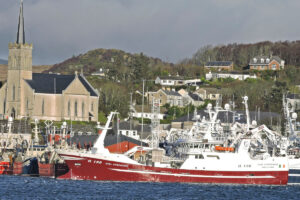
Girl Stephanie berthed at Killybegs, following a stormy delivery passage from Denmark.
SeaQuest Systems also supplied the 18in fish pump and full package of associated deck machinery that Girl Stephanie’s crew use when taking pelagic fish onboard at the stern.
At the end of a successful tow, trawled catches of blue whiting, mackerel or scad are taken aboard aft on the portside of Girl Stephanie, before the fish are pumped forward to the dewatering system mounted atop the shelterdeck amidships.
While using the net drum to dry up the brailler, the 38t tail-end winch, mounted to port on the boat deck, is used to haul the bag back to the quarter, before the sock is attached to the pump located on the raised aft section of the boat deck, just forward of the trawl gantry.
The storage reel for the hydraulic pipes is positioned forward of where the fish pump is secured on the portside boat deck, directly above the fish hose reel on the shelterdeck. After the 18in SeaQuest pump is lowered into the water by the gantry crane and the bag slackened off, 80m of 450mm-diameter fish hose (10mm thick) and 80m of hydraulic hoses are run off the reels.
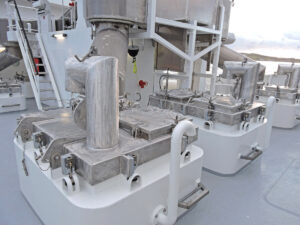
Tank-top arrangements forward on the shelterdeck.
The SeaQuest pump-through hose reel enables the fish hose to be permanently connected to the delivery pipe, to give faster pumping times at a rate of 12-14t per minute.
A large-diameter stainless steel delivery pipe extends from the quarter, some 30m forward on the portside of Girl Stephanie, to the fish/seawater separator system amidships.
Karstensens liaised closely with the owners to place a strong emphasis on the requirement to land a top-quality product into what is a highly competitive international marketplace.
Mounted on top of the deckhouse at forecastle deck level, the seawater separation system, designed and manufactured in-house by Karstensens Shipyard, delivers pelagic fish into the selected combination of stainless steel chutes for delivery down into one of Girl Stephanie’s eight RSW tanks, which have an internal volume of 850m³. A 16in stainless steel pipe that enters the forward end of the separator also allows Girl Stephanie to take fish from Western Chieftain.
The forward and aft tiers consist of three tanks, with two amidships either side of a central pump room.
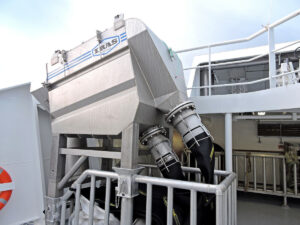
Girl Stephanie’s IRAS vacuum landing delivery system.
While this arrangement is primarily designed to ensure that the vessel settles on a level trim when returning to harbour after a successful trip, thereby increasing freeboard, safety and fuel efficiency, this central location also brings the added benefit of ensuring shorter and more equal pipe runs and fewer internal pipes routed through the tanks. A central corridor runs between the insulated tanks at main deck level to give quick access fore and aft.
Optimal catch quality is achieved by a fully interconnected pumping system that permits circulation for each tank to be managed individually, using the output of two Johnson Controls (York/Sabroe) RSW ammonia-operated chilling systems that can operate separately, delivering 375,000kCal/h each, or be used as one common system, enabling pelagic catches to be brought down to the desired storage temperature of -2°C often in less than two hours, depending on the quantity of fish pumped aboard and the number of RSW tanks brought into use. The RSW system includes 2 x 460m³hr circulation pumps and 2 x 160m³hr condenser pumps.

The first Girl Stephanie…
All controls for the pneumatic cylinders used to direct the flow of fish from the separator unit are housed in the RSW control room, the port side of which contains a dedicated wet room where selections of pelagic fish are sampled using a set of Marel M2200 electronic scales, from which all information is automatically transferred to skipper Tomás Conneely in the wheelhouse.
Pelagic catches are discharged ashore by an IRAS vacuum pumping system that incorporates two 2,800-litre tanks and three 55kW compressors. The vacuum pumps and compressors are positioned at main deck level between the forward tier of RSW tanks, forward of the similarly arranged RSW machinery situated between the middle and aft tier of tanks. The central RSW pump room is located one deck lower.
Fourth Girl Stephanie
Girl Stephanie is the fourth family boat to take her name from skipper Tomás Conneely’s sister Stephanie Flaherty.

… was renamed Vertrauen on moving to Scotland in 1996 as part of the transaction in which…
Skipper Pauric Conneely took delivery of the first, a 26.5m wooden-hulled trawler, in 1982, when the boat was built at the Maritime Industries boatyard in Cork. Equipped with a Caterpillar D398 main engine and Pay & Brink gearbox, this boat had three tanks with a combined capacity of 120m³. The original Girl Stephanie paired with skipper Gerry McNern’s Silver King.
After performing consistently well for 14 years, the original Girl Stephanie was replaced in 1996 when skipper Pauric Conneely bought the 34.72m steel-hulled purse-seiner Julieanne BF 250 from Gardenstown skipper Alex West. The transaction included Girl Stephanie moving to northeast Scotland to become the whitefish trawler Vertrauen BF 450, skippered by Billy Edwards. The Fraserburgh-based Vertrauen was lost when fishing in the North Sea in 2000.
Before leaving Scotland for Co Galway, Julieanne was extensively converted to fish as a midwater trawler, when a new towing gantry, a pair of split winches, net drum and powerblock were fitted. Four years later, this boat was re-engined in Frederikshavn with a MAN unit.

… Julieanne became the second Girl Stephanie.
Julieanne was one of five sub-80ft dual-purpose purse-seiner/trawlers built at the Maaskant Shipyard in Holland in the mid-1970s, one of which was the Co Donegal-owned Albacore D 387. When new, the open-decked Julieanne featured an 850hp Mirrlees Blackstone main engine and three RSW tanks plus a dry hold. Julieanne was lengthened to 24.5ft in 1978, when additional catch-storage tanks were added, at the same time as the vessel was shelterdecked and the wheelhouse raised. After being re-engined with a Stork Werkspoor unit in 1983, Julieanne was lengthened for a second time in 1988, when a new wheelhouse was fitted.
When Karstensens Shipyard was building the third Girl Stephanie, a custom-designed 45m midwater trawler, her predecessor was sold to Aran Islands skipper Thomas Flaherty and renamed Westward Isle G 185 in 2004. The new Girl Stephanie featured a MAN Alpha 6L27/38 main engine, Rapp Hydema deck machinery and six RSW tanks.








